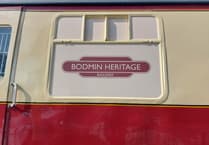WHILE the news recently has concerned a single complaint to CAMRA seeing it stripped of its pub of the year award over an 80-year-old World War II artefact, it takes only a visit to or a conversation with a local to understand that Bodmin’s Hole in the Wall is a hot-bed of local curiosities and history stretching back to the 18th century.
Indeed, its name is a nod to that history, which began as a debtor’s prison between 1749 and 1779. A debtor’s prison was a primitive type of prison where those who owed money would be imprisoned, with the name of the venue referring to the fact that prisoners would be passed food through a hole in the wall.
Lovingly run for the past two decades by landlord Steve Hall, the pub has continued its historical tradition of being an old-fashioned gathering place for locals, albeit with the only cell being the cellar where the barrels are stored.
The first oddity that draws the attention upon arrival at the venue is the presence of a stuffed lion behind a glass cabinet.

Its origins are a story which has been passed down through the generations of landlords who have tended to the pub and its locals, but it is believed to involve an Okehampton pub and two rugby teams.
Steve Hall, the present landlord, regales this tale to any curious visitor, stating: “The story goes that it was stolen over 60 years ago by players of the Launceston Rugby Club when on a night out at the White Hart Hotel in Okehampton.
“After stealing this stuffed lion, they realised that actually, it was quite valuable, and so they kept it. For a while, they kept it under mothballs for a period of time before hitting on the idea to use it as a trophy, where they’d play for it against other rugby teams.
“They lost the trophy when playing against a newly formed Liskeard and Looe rugby team, who won the lion and proceeded to parade it through the streets of Liskeard.
“The team had no clubhouse so ended up putting the lion in what was then the Webb’s Hotel, on the Parade in Liskeard, but the owner was having none of it and demanded it was removed from the hotel.
“He had given the team a few weeks grace to remove this giant stuffed lion from the hotel, and the team had gone to see the then-landlord of the Hole in the Wall, which I believe, and I could be wrong, was a man called Joe Lewis.
“They then decided to barter the lion for draught bass beer, and that’s how a lion ended up displayed at the Hole in the Wall, where it has been ever since!”

Adorning the interior of this welcoming, old-fashioned venue, complete with a roaring fire, are a litany of artefacts spanning a variety of eras and types. A quick look at the ceiling beams surrounding the bar demonstrates many of these items.
These include old de-activated guns, a visual encyclopaedia of coasters stretching back a number of years, vintage local signs, including one about bombs and another prohibiting juvenile smoking in the ‘borough of Bodmin’, coins, old foreign currency and old hats among the history on offer.
Some of the guns and other war artifacts were likely to have been brought back by Cornish soldiers returning from service in World War II, based at the nearby now-former Bodmin Barracks with their presence marking the role in history they played.
In addition, the venue, adorned with vintage bar furniture, has plaques dotted around the place in tribute to former bar staff and locals who have passed away, dedicated in their memory, as well as more than one wooden boat.

All of the items which decorate the pub have been passed down through the generations of the venue’s custodians, many of which stretch back multiple generations and were used as barter in exchange for alcohol.
One regular, former postman Phil Brown tells a story of the role played by the pub at Christmas. He said: “Most years, a group of us have come down on Christmas Eve and often don’t remember leaving. While there, we sing all the Christmas carols, and the rest of the pub would join in, and it still goes on today occasionally.”
The venue is also one of the stopping places for the historic Bodmin Wassail, which tours the town on the twelfth night in January, performing for residents and raising money for local good causes.
It is a venue which bears the tale of generations of Bodmin locals, whose parents, grandparents and great grandparents enjoyed the venue as those present today still do, and remains as a historical curiosity from which you can still enjoy a pint of refreshing draught ale.




